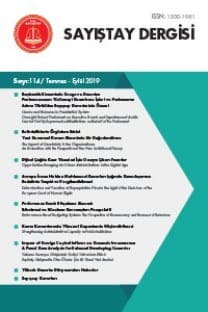Türk Bankacılık Sektöründe Vergi Planlaması Analizi
Vergi Planlaması, Bankacılık Sektörü, Lojistik Model.
TAX PLANNING ANALYSIS IN TURKISH BANKING SECTOR
Tax Planning, Banking Sector, Logistic Model.,
___
- Adrian, T. ve Shin H. S. (2010), Liquidity and Leverage, Federal Reserve Bank of New York Staff Reports, 328, 1-37.
- Akdoğan, A. (2007), Kamu Maliyesi, (12. Baskı), Ankara: Gazi Kitabevi.
- Amadasun, A. B. ve Igbinosa, S. O. (2011), “Strategies for Effective Tax Planning”, Franklin Business & Law Journal, 2, 51-64.
- Armstrong, C. S., Blouin, J. L. ve Larcker, D. F. (2012), “The Incentives for Tax Planning”, Journal of Accounting and Economics, 53, 391-411.
- Berkson, J. (1951), Why I Prefer Logits to Probits, Biometrics, 7(4), 327-339.
- Binici, M. ve Köksal, B. (2012), Kaldıraç ve Döngüsellik, TCMB Ekonomi Notları, 11, 1-9.
- Blouin, J. (2014), “Defining and Measuring Tax Planning Aggressiveness”, National Tax Journal, 67(4), 875-900.
- Cardoso, L. G. M. ve Laruccia, M. M. (2006), “The Quest for Brand Value”, http:// ssrn.com/abstract=1337325 (Erişim Tarihi: 06.12.2016).
- Cramer, J. S. (2002), The Origins of Logistic Regression, Tinbergen Institute Discussion Paper, 119(4), 1-15.
- Dayton, C. M. (1992), Logistic Regression Analysis, Stat, 474-574.
- Dyreng, S. D., Hanlon, M. ve Maydew, E. L. (2008), Long-Run Corporate Tax Avoidance. The Accounting Review, 83(1), 61-82.
- Eriotis, N. P., Frangouli, Z. ve Ventoura-Neokosmides, Z. (2002), Profit Margin and Capital Structure: An Empirical Relationship, Journal of Applied Business Research, 18(2), 85-88.
- European Commission (2012), “Clamping Down on Tax Evasion and Avoidance: Commission Presents the Way Forward”, http://europa.eu/rapid/pressrelease_IP-12-1325_en.htm#PR_metaPressRelease_bottom (Erişim Tarihi: 16.11.2016).
- Gallemore, J., Gipper, B. ve Maydew, E. L. (2016), “Banks as Tax Planning Intermediaries”, https://ssrn.com/abstract=2796132 (Erişim Tarihi: 16.03.2018).
- Gerçek, A. ve Uygun E. (2018), “OECD Ülkelerinde Agresif Vergi Planlamasını Önlemeye Yönelik Tedbirlerin Değerlendirilmesi”, Vergi Sorunları Dergisi, 360, 34-49.
- Guenther, D. A., Matsunaga, S. R. ve Williams, B. M. (2013), “Tax Avoidance, Tax Aggressiveness, Tax Risk and Firm Risk”, https://business.illinois. edu/accountancy/wp-content/uploads/sites/12/2014/10/Tax-2013- Guenther.pdf (Erişim Tarihi: 08.06.2017).
- Gujarati, D. N. (2006), Temel Ekonometri, (4. Baskı), Ümit Şenesen & Gülay Günlük Şenesen (Çev.), İstanbul: Literatür.
- Hong, Q. (2010), “International Taxation and Income-Shifting Behaviour of Multinational Corporations (Doctoral Dissertation)”, http://hdl.handle. net/1807/26189 (Erişim Tarihi: 27.02.2018).
- Hong, Q. ve Smart, M. (2010), In Praise of Tax Havens: International Tax Planning and Foreign Direct Investment, European Economic Review, 54, 82-95.
- Huang, W., Ying, T. ve Shen, Y. (2018), Executive Cash Compensation and Tax Aggressiveness of Chinese Firms, Review of Quantitative Finance and Accounting, 1-30.
- Internal Revenue Service (2017), “FASB Interpretation No. 48, Accounting for Uncertainty in Income Taxes”, https://www.irs.gov/businesses/ corporations/fasb-interpretation-no-48-accounting-for-uncertainty-inincome-taxes (Erişim Tarihi: 07.04.2017).
- İbiş, C. (2004), “İşletmelerde Vergi Planlaması”, Mali Çözüm Dergisi, 68, 72-79.
- Kubick, T. R., Lynch, D. P., Mayberry, M. A. ve Omer, T. C. (2014), “The Effects of Increased Financial Statement Disclosure Quality on Tax Avoidance: An Examination of SEC Comment Letters”, https://scprod1 lb.mccombs.utexas. edu/~/media/Files/MSB/Departments/Accounting/Brownbag%20 papers/LynchUTWorkshop952014.pdf (Erişim Tarihi: 18.03.2018).
- Lynch, D. (2014), “Investing in the Corporate Tax Function: The Effects of Remediating Material Weaknesses in Internal Control on Tax Avoidance (Doctoral Dissertation)”, https://search.proquest.com/openview/d8c883 2b465ce6cb000f875bf755786b/1?pq-origsite=gscholar&cbl=18750&di ss=y (Erişim Tarihi: 17.03.2018).
- Neuman, S. S. (2014), “Effective Tax Strategies: It’s Not Just Minimization (Doctoral Dissertation)”, https://ssrn.com/abstract=2496994 (Erişim Tarihi: 13.03.2018).
- Payne, D. M. ve Raiborn, C. A. (2018), Aggressive Tax Avoidance: A Conundrum for Stakeholders, Governments, and Morality, Journal of Business Ethics, 147(3), 469-487.
- Reiter, F. (2017), “Avoiding Taxes: Banks’ Use of Internal Debt”, https://www. econstor.eu/bitstream/10419/168115/1/VfS-2017-pid-2319.pdf (Erişim Tarihi: 04.02.2018).
- Saraçoğlu, F. (2006), “Transfer Fiyatlandırmasının Vergisel Amaçları, Karşılaşılan Sorunlar ve OECD-AB Yaklaşımı”, Lebib Yalkın Mevzuat Dergisi, 32, 106- 112.
- Slemrod, J. ve Wilson, J. D. (2006), Tax Competition with Parasitic Tax Havens, NBER Working Paper Series, 12225, 1-43.
- Şişman, B. (2003), İşletmelerde Vergi Planlaması Yöntemleri. İstanbul: Yaklaşım Yayınları.
- Taşkın, Y. (2012), “Vergi Planlaması Yöntemi Olarak Amortismanların Vergi Usul Kanunu ve Türkiye Muhasebe Standartları Açısından Değerlendirilmesi”, Mali Çözüm Dergisi, 114, 99-111.
- Uluyol, O., Lebe, F. ve Akbaş, Y. E. (2014), “Firmaların Finansal Kaldıraç Oranları ile Öz Sermaye Kârlılığı Arasındaki İlişki: Hisseleri Borsa İstanbul (BİST)’da İşlem Gören İşletmeler Üzerinde Sektörler Bazında Bir Araştırma”, İşletme Araştırmaları Dergisi, 6(1), 70-89.
- ISSN: 1300-1981
- Yayın Aralığı: 4
- Başlangıç: 1990
- Yayıncı: T.C. Sayıştay Başkanlığı
Kara Para Aklamada Yeni Yöntemler ve Kara Paranın Ekonomi Üzerindeki Etkileri
Obezite Vergisinin Kabul Edilebilirliğine İlişkin Yapısal Eşitlik Modeli Analizi
Türk Bankacılık Sektöründe Vergi Planlaması Analizi
Hilmi ÜNSAL, Selin ERTÜRK ATABEY, Gonca BIYIK
